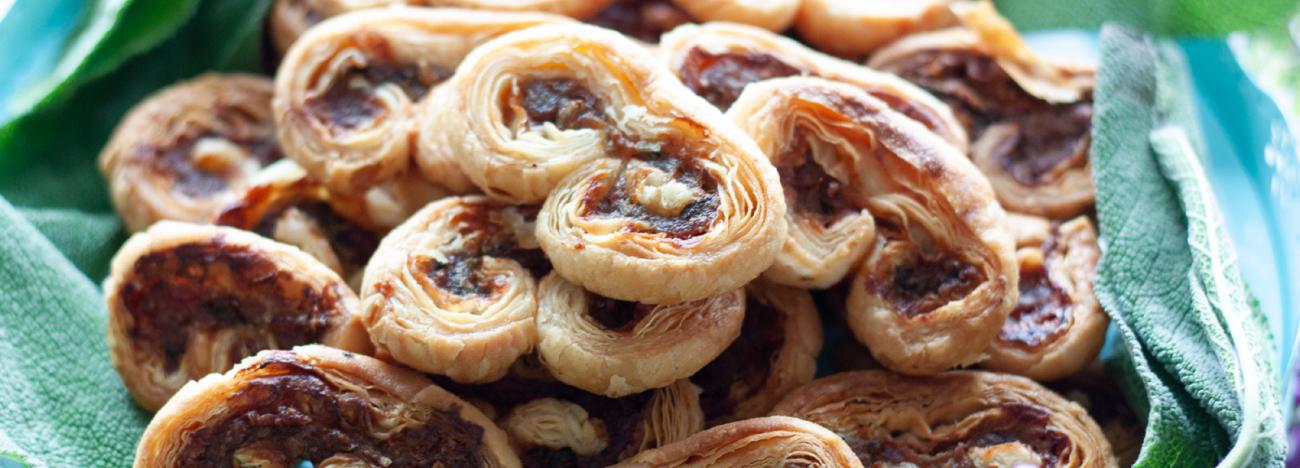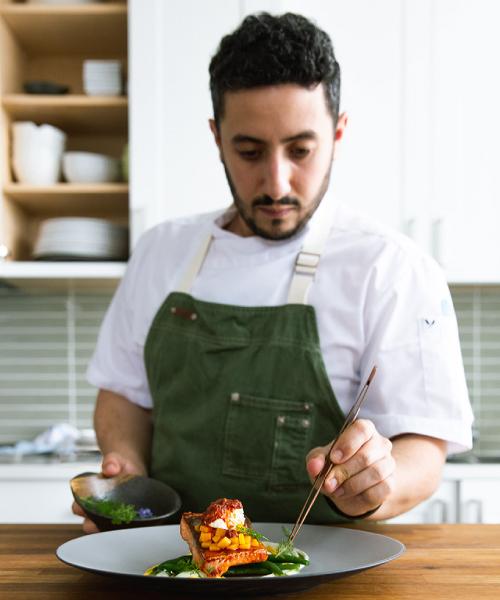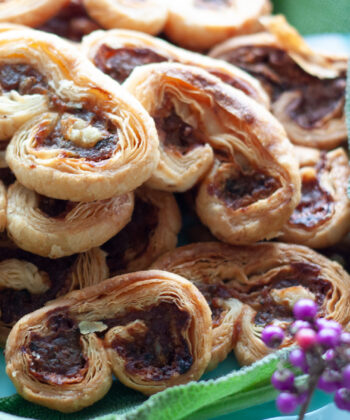Table Talk
Evan Elman, BA’14
Evan Elman, like Odysseus, is a man of twists and turns – someone in possession of intense focus and discipline, with an impressive ability to steer himself into seemingly endless calamities. (He’ll cheerfully say things like, “So after almost dying in Antarctica, I swallowed paint thinner by accident.”) Somehow, he’s still here to tell the tale. After working as a line cook throughout his time at UBC, Elman entered Vancouver’s high‑end dining scene at places like the Flying Pig, Hawksworth, and Relais & Chateaux’s Wedgewood Hotel. Along the way, he had a few adventures.
There was his stint in Antarctica as sous‑chef on a Russian research‑vessel‑turned‑cruise‑ship, where he spent his rare breaks getting up close and personal with 600 penguins (“some pecked at me”), and the rest of his time cooking for 120 passengers. The cooking and dining conditions were far from ideal. During one storm in the Drake Passage, some of the roughest seas in the world, “We got hit with a rogue wave that knocked everybody’s plates off their tables at dinner,” Elman recalls. In the kitchen, pots of boiling water and hot oil flew off the stove, and outside it was so cold that seawater froze onto the boat, slowly dragging it sideways and requiring crew members to pound its side with sledge hammers throughout the night. Elman says he feared for his life. “I was thinking, This ship’s for sure gonna capsize.” Regardless, he made dinner.
The Antarctic storms actually weren’t so bad, Elman reflects, compared to the month he spent cooking on a fishing boat: “That was bad, because those guys were a bunch of sociopathic fishermen from Courtenay.” A drunken fisherman cornered Elman in the walk‑in fridge, threw boxes of food out the window, and hit him in the face with a metal bar. “It was aluminum, so it wasn’t devastating,” Elman says. “But my nose was bleeding everywhere. I got $5000 for the month – not worth getting beat up in a cooler.”
Aside from the hazards of catastrophic storms, aluminum bars to the face, and drinking paint thinner in Tierra del Fuego (someone had stored it in a water bottle; Elman was fine, although he did have to endure “a Russian doctor screaming” as he threw up over the toilet, “getting fed charcoal by some Californian doctor,” and “burping up paint thinner for the next two weeks”), the chef values his time working in extreme conditions. On the ships, he says, “I had nowhere to run. I had no vices. I had no contact with the outside world. I had no one to give me a hug and tell me things would be okay.” The result, though emotionally trying, was a creative immersion: “If you lock yourself in a room for 50 days, you’re going to make something incredible, and you’re going to train yourself to become more diligent and more patient.”
Diligence is certainly a quality Elman possesses; he’s no stranger to 80 consecutive work days and 15‑hour shifts. Eventually, though, the fascination with all‑encompassing work and far‑flung adventure began to wane. When Elman met his now‑fiancée, with whom he has a baby girl, for the first time he wanted to slow down and stay close to home. “I have so much more to lose at this point,” he says.
His definition of slowing down, of course, is not entirely sedate. Elman became executive chef at Dinner in the Sky, where staff and guests float in harnesses, strapped to an outdoor table, 100 feet off the ground. Most recently, Elman started Verde Experiences, offering private fine‑dining and catering meals infused with cannabis. The company creates gourmet food, he says, with the option to dose precise amounts of cannabis – a classy upgrade, his website says, on the days of “getting far too stoned and waking up the next morning covered in Cheeto dust, realizing I’d binge‑watched all three Robo‑Cops.”
In the absence of adrenaline‑pumping conditions, what keeps Elman excited in the kitchen? His diners taking their first bites. “It’s just this moment – a 10‑second window – where all you hear is quiet, cutlery clinking on the plates, and then, Oh my God, this is sooo good. Being able to change people’s experience for that brief moment is so gratifying.” Quiet, when you’re doing what you love, is as thrilling as 10‑metre waves in the Drake Passage.
Yield: 15 servings
Prep time: 30 min
Total time: 1.5 hrs
Extra Virgin Olive Oil (EVOO) - 1 T
Shallots - 2 Finely chopped
Free‑range Sausage meat - 50g
Ground Pork - 50g
Sage - 10 Leaves, finely sliced
Puff Pastry - 75g Rolled Out
S+P - To Taste
1. Heat the oil in a small frying pan, then gently fry the shallots for 10 minutes until soft. Transfer to a mixing bowl to cool. Add the sausage meat, pork mince and sliced sage to the bowl, season and mix well. To test if the seasoning is right, fry a little of the mixture in a pan until cooked, then season to taste.
2. Unroll the pastry sheet and spread evenly with the pork mixture, leaving a 1cm border around each edge. Roll up each long side to halfway so they meet in the middle. Chill in the fridge for at least 1 hour (or wrap well in cling film and freeze until ready to cook).
3. Preheat the oven to 400°F. Cut the chilled roll into slices about 7mm thick, then arrange over 2 baking sheets, leaving a 5cm gap between each slice as they’ll spread a little as they cook. Bake for 20‑25 minutes until golden and puffed. Serve warm.
Gwendolyn Richards, MJ’13
When Gwendolyn Richards was a crime reporter at the Calgary Herald, she’d show up at crime scenes in red, patent, peep‑toe high heels. She spent her work days listening to a police scanner, then rushing to the scenes of accidents or interviewing people who had lost loved ones in shootings. At the end of those devastating days, Richards would seek refuge in her kitchen, where the “bright, hot, sour flavours” she brewed up, like her red shoes, created a bit of stubborn happiness.
The comfort that cooking evoked was especially welcome for Richards in April 2008, when she was reporting on a gang war gripping Calgary with near‑record numbers of homicides. Desperate to immerse herself in something that wasn’t unrelentingly sad, she started a food blog, Patent and the Pantry.
Ever since, she’s been sharing with readers her cooking successes and struggles (scones were nearly her Waterloo), focusing on enjoyment rather than feats of culinary perfection. “Cooking doesn’t have to be a contact sport,” she says – It’s just meant to make you happy.
Following that brightness, Richards left crime scenes behind to become a food journalist and eventually published a cookbook. She knew what her book’s theme would be when an editor at the Herald banned her, a self‑declared citrus fanatic, from pitching any more lemon recipes. In a characteristically bold move, instead of reining in her obsession, Richards made it the star of the show and created Pucker: A Cookbook for Citrus Lovers.
Richards wrote, food‑styled, and photographed the recipes for Pucker while working full‑time at the newspaper – recipe‑testing until 3:00 am, then whizzing back to the office by 7:00. The worst part was not the exhaustion, she says, but the piles of dirty dishes: “Nobody tells you about that part! If you’re a famous chef you have minions to do that, but not so much when you’re just doing it at home.”
The sleepless, minion‑less grind was worth it, Richards says, when she heard from people who loved the results. She delights in knowing she’s created dishes that strangers crave and share around their dinner tables.
Does Richards cook in red heels, too? “No high heels in the kitchen!” she says. “That’s not safe.” For cooking, she prefers pyjamas.
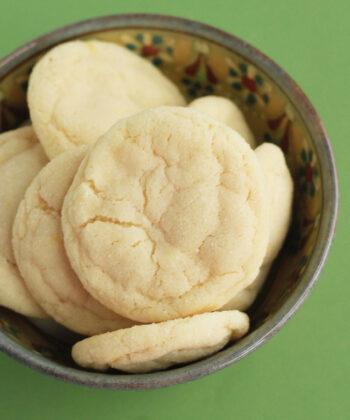
Chewy Lemon Cookies
Makes about 30 cookies
2 3/4 cups (685 mL) flour
1 teaspoon (5 mL) baking soda
1/2 teaspoon (2 mL) baking powder
1/2 teaspoon (2 mL) salt
1 cup (250 mL) butter, softened
1 1/2 cups (375 mL) sugar, divided
Zest of 1 lemon
1 egg
1/4 cup (60 mL) lemon juice
Preheat the oven to 350°F (180°C) and prepare a cookie sheet by lining it with parchment paper.
In a medium bowl, mix together the flour, baking soda, baking powder and salt.
In the bowl of a stand mixer fitted with the paddle attachment, beat together the butter and 1 1/4 cups (310 mL) sugar until pale and fluffy, scraping down the side as necessary. Beat in the zest until well combined.
With the mixer on medium speed, add the egg, then the lemon juice, beating until incorporated. Add the flour mixture and mix on low speed until just combined.
Using a spoon, scoop out 1‑inch (2.5 cm) balls of dough and roll them between your hands to form spheres. Drop into a small bowl of the remaining 1/4 cup (60 mL) of sugar and roll gently with your fingertips to coat the dough on all sides.
Space the dough balls about 2 inches (5 cm) apart on the cookie sheet and bake until the edges are cooked but the tops are still puffy, about 8 to 10 minutes. The cookies will be barely golden at the edges and still look ever so slightly uncooked on top. Cool on the cookie sheet for a few minutes, until the tops have fallen and crinkled. Remove to a cooling rack.
Naz Deravian, BFA’94
Naz Deravian is fascinated by memory. It’s at the centre of her award‑winning blog and cookbook, both called Bottom of the Pot, in which she weaves together recipes and reminiscences about her family’s life in the wake of the Iranian Revolution. Charting their journey from Tehran to Rome to Vancouver to Los Angeles, Deravian’s writing is laden with wistfulness for her lost childhood home and bright with a sensual attention to the present.
The results are mouthwatering. Saffron‑scented rice with a crust crispy from the bottom of the pot, sour cherry and feta crostini, fava beans with mint and pistachio sauce, and “flowers and nightingales ice cream” are a few of the delights in Bottom of the Pot, which makes Persian home‑cooking accessible – and enticing – to the uninitiated.
As passionate as Deravian is about cooking, she’s quick to say that she’s not a chef but a storyteller. Having graduated with a BFA in theatre, she worked in film and television in LA until her eldest daughter was born, when the demands of being a new mom made her eager for a way to be creative on her own terms. Cooking had always been a respite – “I call my cutting board my yoga mat” – so she began a food blog, and then transformed the collection of vignettes and recipes into a book through a gruelling writing process she likens to childbirth.
If Bottom of the Pot is Deravian’s baby, it is also a tribute to her mother. Renowned in Iran as a professor, poet, and Iran’s first female lyricist, Deravian’s mother had to improvise a way to support the family when they immigrated to Canada. On a whim, she offered to supply a Vancouver deli with homemade Persian bread – not mentioning to the deli owner, of course, that she had never baked bread in her life. Somehow, she got the contract, necessitating a frantic long‑distance phone call to a favourite bakery in Iran to ask how, exactly, a person makes bread. Across the chaos of “the dialing of rotary phones, a lot of crackling on the line, and plenty of yelling ‘allo, allo’ over and over again,” Deravian’s mother scribbled down the method yelled back to her. The poet turned out to have a knack for baking. Her bread business succeeded wildly, and the family’s livelihood in Canada was secured.
For Deravian, part of the magic of food is that the tastes of home are transmittable across phone lines and portable across continents. Cooking offers her a path back to the people and places she left behind as a child, evoking memories with every whiff: “A bottle of rose water, the bitter tang of a dried lime. Sometimes that’s all it takes.”
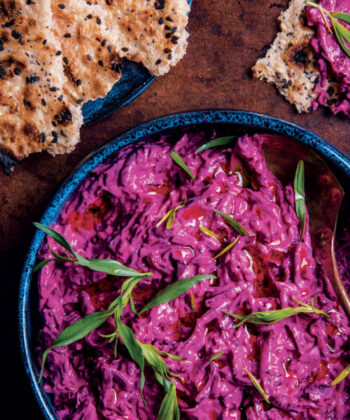 Borani‑yeh Laboo / Yogurt Beet Dip
Borani‑yeh Laboo / Yogurt Beet Dip
Nothing brightens up a meal and everyone’s moods more than a bowl of this fuchsia Borani‑yeh Laboo. The tang from the vinegar and yogurt balances and cuts through the earthy sweetness of the beets, and the tarragon adds a fresh bite. You can cook the beets by steaming them on the stovetop or in the oven. Or you can simply use store‑bought cooked beets. Scoop up withwarm lavash bread, or spread on crisp endive leaves for a striking mazeh.
Serves 6
1 medium beet, cooked and peeled
1 cup Greek yogurt
3 tablespoons red wine vinegar
¼ teaspoon kosher salt
1 teaspoon dried mint
1 teaspoon finely chopped fresh tarragon (optional)
Olive oil for drizzling
Into a medium bowl, grate the beet on the large holes of a box grater. Add the rest of the ingredients, except the olive oil, and mix to completely combine. Taste to make it delicious, keeping in mind that the flavors will develop and deepen as the dip rests. Cover and place in the fridge for at least 1 hour for the flavors to develop before serving. Stir, drizzle with olive oil if you like, and serve.
MAKE AHEAD: Prepare up to 3 days in advance and store in the fridge in an airtight container. If the yogurt weeps, simply stir to incorporate again. Drizzle with olive oil before serving.
Excerpted BOTTOM OF THE POT: Persian Recipes and Stories by Naz Deravian. Copyright © 2018 by Naz Deravian. Reprinted with permission from Flatiron Books. All rights reserved. Photography by Eric Wolfinger.

























